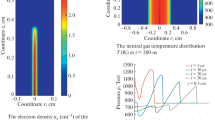Abstract
A method is developed for determining threshold for the development of the instability of a gas discharge in a helium–neon ring laser, taking into account the distributed capacitance “positive column– grounded screen”. In the developed approach to the analysis of stability, the positive discharge of the column is replaced by an equivalent circuit, containing the series connection of negative dynamic resistance ρ and parallel RL circuits. An equivalent circuit can be designed by experimental studies of the linear response of a gas-discharge plasma to weak harmonic perturbations, presented in the form of frequency dependences of the complex resistance Z of the positive column. The calculation of the threshold of instability development in the electrical circuit of a bilateral discharge only on the basis of the experimentally recorded frequency dependence of the complex resistance of the positive column does not allow one to extend the quantitative analysis to conditions beyond the range of those in which the measurements are performed. To overcome this limitation, which hinders the search for the operating current, in which the development of instability is excluded for the entire temperature range of operation of helium–neon ring lasers, a model is developed that describes the positive column of the gas discharge. The boundary of the unstable state of the bilateral gas discharge in the space of parameters is found to be as follows: the resistance of ballast resistors, temperature, and circuit capacitance. The results obtained make it possible to maintain a bilateral DC discharge in a given range of temperature variation.






Similar content being viewed by others
REFERENCES
Yu. Yu. Kolbas, M. E. Grushin, and V. N. Gorshkov, Quantum Electron. 48, 283 (2018).
E. A. Izmailov, S. E. Kukhtevich, V. V. Tikhomirov, D. V. Stafeev, and A. V. Fomichev, Girosk. Navig., No. 2, 89 (2015).
Yu. Yu. Kolbas, M. E. Grushin, V. N. Gorshkov, Quantum Electron. 48, 283 (2018).
V. L. Granovskii, Electric Current in Gases: Steady Current (Nauka, Moscow, 1971) [in Russian].
Y. B. Golubovskii, V. O. Nekuchaev, and I. A. Porokhova, Electron Kinetics and Applications of Glow Discharges (Plenum, New York, 1998).
Kh. N. Dao and V. V. Klimakov, in Proc. Int. Sci. Tech. Conf. “I Modern Technologies in Science and Education” (Ryazan, 2017), p. 262.
V. V. Klimakov, A. V. Molchanov, A. I. Ulitenko, and M. V. Chirkin, Vestn. Ryazan. Gos. Radiotekh. Univ., No. 39-2, 48 (2012).
A. I. Ulitenko, V. V. Klimakov, A. V. Molchanov, and M. V. Chirkin, Radiotekhnika, No. 3, 171 (2012).
A. V. Molchanov, D. A. Morozov, S. V. Ustinov, and M. V. Chirkin, Vestn. Ryazan. Gos. Radiotekh. Univ., No. 54-2, 115 (2015).
A. V. Ermachikhin and V. G. Litvinov, Instrum. Exp. Tech. 61, 277 (2018). https://doi.org/10.1134/S0020441218020021
Kh. N. Dao, V. V. Klimakov, A. V. Molchanov, and M. V. Chirkin, Vestn. Ryazan. Gos. Radiotekh. Univ., No. 59, 136 (2018). http://www.doi.org/10.21667/1995-4565-2017-59-1-136-144
D. U. Allan, Girosk. Navig., No. 4, 3 (2015). http://www.doi.org/10.17285/0869-7035.2015.23.4.003-028
A. A. Aviev, V. N. Enin, and I. V. Saneev, Nauka Obraz., No. 6, 145 (2016).
A. G. Kuznetsov, A. V. Molchanov, M. V. Chirkin, and E. A. Izmailov, Quantum Electron. 45, 78 (2015).
V. I. Vinogradov and A. V. Eletskii, Opt. Spektr. 37, 850 (1974).
V. I. Vinogradov and A. V. Eletskii, Opt. Spektr. 62, 51 (1987).
E. F. Polikovskii, A. V. Molchanov, and V. I. Kremer, Proc. 3rd Int. Symp. on Aerospace Instrumentation Technologies (St. Petersburg, 2004), p. 28.
A. V. Molchanov, V. M. Suminov,and M. V. Chirkin, Aviakosm. Priborostr., No. 9, 12 (2004).
F. Aronowitz, in Optical Gyros and Their Application (Paris, 1999), p. 3.
D. P. Luk’yanov, V. Ya. Raspopov, and Yu. V. Filatov, Applied Theory of Gyroscopes (Elektropribor, St. Petersburg, 2015) [in Russian].
Author information
Authors and Affiliations
Corresponding author
Ethics declarations
The authors declare that they have no conflicts of interest.
Rights and permissions
About this article
Cite this article
Chirkin, M.V., Ustinov, S.V., Mishin, V.Y. et al. On the Stability of a Bilateral Discharge in a Ring Laser. J. Surf. Investig. 17, 612–619 (2023). https://doi.org/10.1134/S1027451023030047
Received:
Revised:
Accepted:
Published:
Issue Date:
DOI: https://doi.org/10.1134/S1027451023030047



